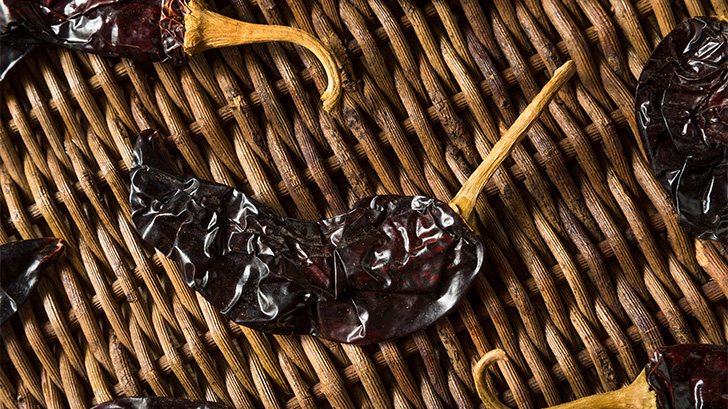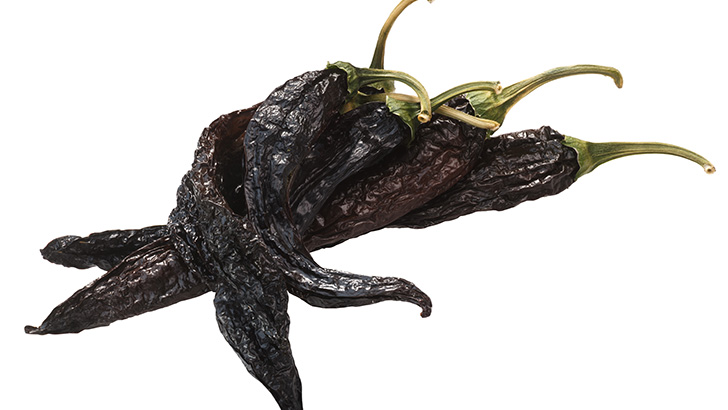Guajillo pepper is star ingredient in your enchilada sauce and the supermarket is fresh out. Isn’t that always the way?
Don’t panic. Below, there are six reasonable guajillo chili substitutes you can instead: cayenne pepper, chili de arbol, paprika, Ancho chili powder, New Mexico chili, and Pasilla chili. These have varying spice levels, so read on to see how to measure the substitution and how it’ll change the flavor of your dish.
A bit about Guajillo peppers
Guajillo pepper is a dried chili pepper that’s popular in Mexican cuisine. It has a medium to mild spiciness, according to its Scoville rating of 2,500 to 5,000.
In terms of looks, the Guajillo pepper has an elongated shape and smooth skin. Its color is red to dark reddish-brown. Nutritionally, Guajillo pepper is a good source of antioxidants, vitamins, and minerals.
You can usually find Guajillos in Mexican grocery stores and online stores, including Amazon.

What does guajillo pepper taste like?
The Guajillo pepper has a unique flavor profile that balances fruity, smoky, and berry taste notes. That nuanced profile makes it a nice fit in sauces, salsas, marinades, soups, stews, and meat rubs. Guajillo pepper is often included in recipes alongside garlic, onion, cumin, coriander, or oregano.
How spicy is guajillo pepper?
As noted, the Guajillo chili’s Scoville rating is 2,500 to 5,000. SHU. That’s hotter than the average Anaheim pepper but milder than the average Jalapeno. Most would label that as mild to moderate in spice. If you like a little heat, but find that Jalapenos to be overpowering, then the Guajillo probably suits your tastes well.
Like any chili, the heat of the Guajillo pepper can vary depending on its ripeness and the way it is prepared. If you like things spicy, grind up dried Guajillo pepper and use it as a powder. If you want to lessen the heat, soak the dried peppers in water first to reconstitute them.
How Guajillo pepper is used in cooking
Guajillo pepper commonly appears in mole, adobo, and enchilada sauces. Many of these sauces can easily be made with Guajillo substitutes. The end result will have a slightly different spice and flavor profile, but can still be enjoyable — as long as you are careful in measuring any substitutions that are naturally hotter than the Guajillo.
Here are some Guajillo pepper recipes from around the web:
6 Guajillo chili substitutes
Guajillo is a dried chili, so the best substitutes are other dried chiles or chili powders. The only tricky part is knowing how the heat of the substitute chili compares to the Guajillo. If your stand-in chili is much hotter, you’ll want to use less of it. Or, if your Guajillo substitute is much milder, you’ll either use more or accept a milder end result.
Below are six common Guajillo chili substitutes, ordered from spiciest to mildest.
1. Cayenne pepper: 30,000-50,000 Shu
- SPICY, CONSISTENT FLAVOR: McCormick Culinary Ground Cayenne Pepper has a spicy, consistent flavor; use this spice to deliver bold, fiery heat; make dishes with world-famous flavor in your kitchen
- HIGH QUALITY: Made from premium cayenne peppers ground into a deep red color and fine texture for visual aesthetic and more practical enhancements to your favorite recipes
- MADE FOR CHEFS: McCormick Culinary Ground Cayenne Pepper comes in a 15-ounce container, perfect for large batches in commercial kitchens; buying bulk cayenne pepper saves time and money
- CONSISTENT AND CONVENIENT: Perfect for tomato-based sauces, seafood, meat, rubs and marinades; cayenne pepper powder offers performance and flavor consistency as a culinary pantry staple
- A BRAND YOU CAN TRUST: McCormick Culinary’s Cayenne Pepper is kosher with no added MSG; serve more customers with confidence knowing that you can accommodate their dietary needs
You may have cayenne pepper in your pantry, which makes it an easy option when you can’t find Guajillo. Just know that cayenne pepper is MUCH hotter than Guajillo — about 10 times hotter according to the Scoville scale. When using cayenne instead of Guajillo, start with a dash and then add more to taste.
Cayenne pepper originates from South America, but is now commonly grown and used all over the world. The spicy, red-orange powder pepper has various health benefits: It reduces inflammation, improves digestion, and boosts metabolism. Cayenne pepper also contains vitamin A, vitamin E, and potassium.
2. Chili De Arbol: 30,000-50,000
- Authentic dries arbol chiles; chiles de árbol are almost always sold dried and unlike other dried peppers, which tend to brown during the drying process, chiles de árbol retain their red color
- Add heat to your dishes; chile de arbol peppers have bold heat with a grilled taste heat index is between 15000 and 30000 scoville units; they are perfect to add some heat to your salsas or dishes
- Grown in the fields of mexico; grown in the beautiful fields of mexico to ensure freshness and authenticity; our chiles are sourced from real farmers to bring authentic and fresh chiles to your table
- All natural no chemicals; our recipe includes no preservatives additives or chemicals to ensure real freshness; quality is our foremost priority
- Packages with care; our arbol chilies are hand selected and hand packed in our gourmet spice shop; for optimum flavor and freshness we recommend washing all chiles before being consumed.
Chili De Arbol is another popular substitute for Guajillo pepper. It’s spicier — along the lines of cayenne — and smokier than Guajillo. So follow the same practice outlined for cayenne. Start with a dash and build based on your taste.
Chili de Arbol is native to Mexico. It is small, slender, and tapered, measuring about 2 to 3 inches in length. It’s used in salsas, sauces, and marinades, and is a key ingredient in adobo, tamales, and pozole. Because of its heat, the pepper is typically used sparingly or in combination with milder peppers to balance the spice.
3. Hatch green chili: 1,000-8,000 Shu
Hatch green chilis, aka New Mexico chiles, are the pride and joy of the state. Research on the heat level of the hatch green chili is all over the place — and honestly, my experience confirms this. Some are very hot and others are mild. Hence the SHU rating ranges from 1,000 to 8,000. A moderate hatch chili can be one of the best Guajillo pepper substitutes.
SInce you never really know what you’re getting with hatch green chiles, do a taste test before you substitute. You’ll know quickly if you have an extra-hot chili on your hands. You can then measure your substitution accordingly.
Hatch chiles have a sweeter and earthier flavor than other chili peppers. They’re harvested green and can be roasted or dried and ground. This chili is so entrenched in New Mexico culture that McDonald’s serves a hatch green chili cheeseburger at its Santa Fe locations. It is commonly used in enchiladas, posole, and other Tex-Mex dishes.
4. Pasilla pepper: 1,000-2,500 SHU
- PREMIUM DRIED PASILLA CHILES – The Pasilla Chile (aka Chile Negro Pepper) is the Dry form of the Chilaca Whole Chili Pepper. It turns from Dark Green to Dark Brown when fully Mature.
- AUTHENTIC FROM MEXICO – 100 % Natural Product Sourced From Farms Throughout Mexico. Grown in the Beautiful Fields of Mexico, our Authentic Mexican Chiles are Hand Selected and Packaged with Care.
- GREAT FOR MEXICAN RECIPES – Pasilla Chiles have a Rich and Tangy Flavor with Mild Heat perfect for Mexican Cuisine Recipes like Pozole, Enchiladas, Chili, Mole, Stews, Salsas, Meats, and many more!
- ALL NATURAL, NO CHEMICALS – Our Recipe includes NO Preservatives, NO Additives and NO Chemicals to Ensure Real Freshness. Quality is our foremost priority! 100% Chile Pepper.
- PACKED WITH CARE – Our Pasilla Chiles are Hand-Selected and Hand-Packed in Our Gourmet Spice Shop. For Optimum Flavor and Freshness, We recommend washing all Dried Chiles before being Consumed.

Pasilla chili is a long, slender, dark green to black pepper with a wrinkled appearance. The name “Pasilla” literally translates to “little raisin,” referring to the way the chili looks after it has been dried. The Pasilla pepper has a deep, rich, and complex flavor with a smoky taste that’s less spicy than Guajillo.
5. Ancho pepper: 1,000-1,500 Shu
Ancho chili is a dried Poblano pepper. It has dark, rust color, and a sweet and smoky flavor. Ancho chili powder is an essential ingredient in many Mexican, Tex-Mex, and Southwestern dishes. It’s quite mild in spice, but more complex than generic chili powder. When substituting Ancho chili powder for Guajillo powder, use the same measurement to start and be prepared to add more to taste.
6. Paprika: 100-500 Shu
- MADE FROM PREMIUM PEPPERS: Made using sweet red peppers to achieve the signature mild, slightly sweet taste
- CONSISTENT QUALITY: Created with culinary professionals in mind; this finely ground spice ensures consistent quality and pure flavor in the kitchen
- PERFECT FOR CHEFS: Ideal for your classic dishes or new menu items that guests will find irresistible
- VERSATILE INGREDIENT: Adds a burst of color, flavor and aroma to appetizers, proteins, marinades and dressings
- FEEL GOOD FLAVOR: Kosher for a bold taste with ingredients you can trust
Paprika or smoked paprika can add a mild, sweet, and smoky flavor to your dish — without heat.
Paprika is another common pantry ingredient, so it’s another convenient substitute for Guajillo. Paprika is made from dried and ground red bell peppers or chili peppers. There are different varieties that highlight different flavor profiles — sweet, smokey, or spicy. Still, even a “spicy” paprika has very little heat.
You can get a nice flavor using paprika as a Guajillo alternative, though you may miss the spice. If you have hot sauce on hand, try adding a dash to your dish if it feels like something is missing. Or, serve the hot sauce on the side so your guests can tailor their own spice level.
How to make chili powder from dried chilis
If your recipe calls for Guajillo chile powder and you only have whole dried chilis on hand, you may need to whip up your own powder. Fortunately, this is an easy thing to do. Once you learn the process, you may want to start making your own custom-blend chili powders.
Start by removing the stems and seeds from your dried chilis. If you want a rich flavor, you can then heat the dried chilis in a pan, gently, until they become fragrant and slightly toasted. Cool them off. Then, using a food processor, grind your toasted chilis into a fine powder. Store any leftover powder in an airtight container so it holds its flavor.
Last update on 2025-11-20 / Affiliate links / Images from Amazon Product Advertising API





